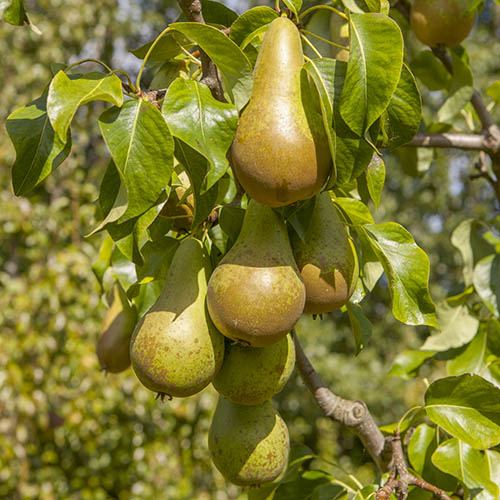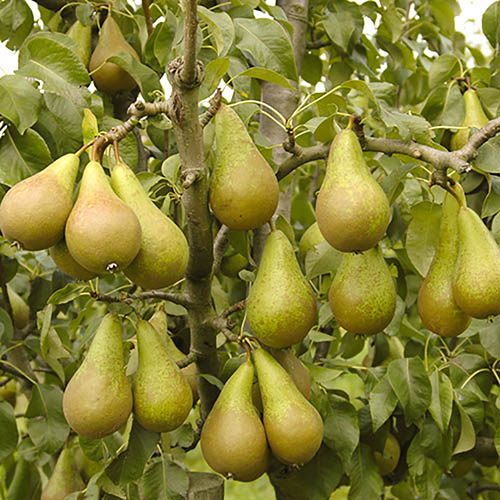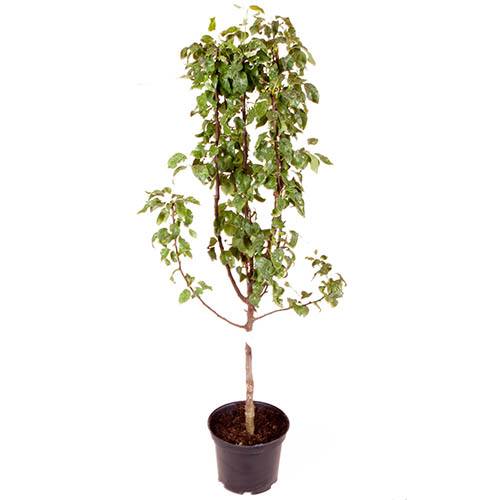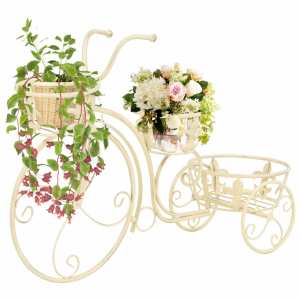Description

Renowned for its juicy, sweet pears, the Conference Patio Pear Tree is perfect for small gardens, patios, and even balconies. This type of tree is low-maintenance and incredibly rewarding. Let’s dive in to learn more about this wonderful fruit tree and how you can grow one in your own space.
What is a Conference Patio Pear Tree?
A Conference Patio Pear Tree is a compact fruit tree that can be grown in smaller outdoor spaces such as patios, balconies, or even small gardens. It is a specially bred variety of pear tree that is known for its ability to thrive in containers and produce an abundant harvest of delicious pears.
Benefits of Growing Conference Patio Pear Trees
Growing Conference Patio Pear Trees offers a range of benefits for both experienced gardeners and beginners alike. Here are some reasons why you should consider adding one to your outdoor space:
- Space-Saving: Conference Patio Pear Trees are specifically designed to grow in smaller areas, making them ideal for urban gardens, balconies, or patios with limited space. Their compact size allows you to enjoy the beauty and bounty of a fruit tree, even in a small outdoor area.
- Easy to Maintain: These trees are relatively low-maintenance, requiring minimal pruning and care compared to larger pear trees. They are also more disease-resistant, making them a suitable choice for novice gardeners or those with limited time for gardening activities.
- Abundant Harvest: Despite their smaller size, Conference Patio Pear Trees are known for their generous fruit production. These trees can yield a significant amount of delicious pears, providing you with a fresh and tasty crop to enjoy throughout the growing season.
- Aesthetically Pleasing: In addition to their fruit-bearing capabilities, Conference Patio Pear Trees also add beauty and elegance to any outdoor space. With their attractive blossoms in spring and lush foliage throughout the year, these trees can enhance the visual appeal of your patio or garden.
How to Grow Conference Patio Pear Trees
Now that you’re aware of the benefits of growing Conference Patio Pear Trees, let’s explore the steps involved in successfully cultivating these compact fruit trees:
- Choosing the Right Container: Select a sturdy container with good drainage to ensure the health and vitality of your Conference Patio Pear Tree. Make sure the pot is large enough to accommodate the tree’s root system and allows room for growth.
- Selecting the Right Location: Place your tree in a spot that receives at least six hours of direct sunlight daily. This will promote healthy growth and ensure optimal fruit production. Consider the microclimate of your outdoor space to provide the best conditions for your tree.
- Planting and Soil: Use well-draining potting soil enriched with organic matter to provide your tree with the necessary nutrients. Ensure that the soil is moist but not waterlogged, as excessive moisture can lead to root rot. Plant the tree at the same level it was in its nursery container.
- Watering and Fertilizing: Regular watering is crucial for the health of your Conference Patio Pear Tree. Keep the soil consistently moist but avoid overwatering. During the growing season, fertilize the tree with a balanced fruit tree fertilizer according to the manufacturer’s instructions to promote healthy growth and fruit production.
- Pruning and Training: Prune your Conference Patio Pear Tree in late winter or early spring to maintain its shape and remove any dead or diseased branches. Additionally, you can train the tree using espalier techniques to maximize vertical space and create an attractive display.
- Pest and Disease Management: Monitor your tree regularly for signs of pests or diseases such as aphids, pear psylla, or pear scab. Take appropriate measures, such as using organic pest control methods or seeking advice from a local horticulturist, to prevent and manage any issues that may arise.
By following these guidelines, you can successfully grow a Conference Patio Pear Tree and enjoy a bountiful harvest of delicious pears, even in limited outdoor spaces. Whether you have a small patio, balcony, or tiny garden, these compact fruit trees offer a rewarding and fruitful gardening experience.
Benefits of Growing Conference Patio Pear Trees
Compact Size and Versatility
Conference Patio Pear Trees offer a wide range of benefits for gardeners with limited space. Their compact size makes them an ideal choice for small gardens or patios. Unlike traditional pear trees, which can grow quite tall and require ample space, Conference Patio Pear Trees have been specifically bred to remain small and manageable. This means that even if you have a small outdoor space, you can still enjoy the beauty and bounty of a fruit-bearing tree.
The versatility of Conference Patio Pear Trees is another key advantage. Due to their compact size, they can be grown in containers, making them the perfect choice for urban gardeners or those with limited outdoor areas. Whether you have a small balcony, a courtyard, or a tiny patch of land, you can easily accommodate a Conference Patio Pear Tree and enjoy its many benefits.
Abundance of Delicious Fruits
One of the most rewarding aspects of growing Conference Patio Pear Trees is the abundance of delicious fruits they produce. Despite their smaller size, these trees are known for their high fruit yield. Imagine stepping outside your door and picking fresh, juicy pears straight from your own tree! Conference Patio Pear Trees offer a truly satisfying fruit-growing experience.
The taste of Conference pears is renowned for its rich and sweet flavour, making them a favourite choice for eating fresh or using in a variety of culinary creations. From salads to desserts and everything in between, the versatility of Conference pears makes them a delightful addition to any kitchen. Plus, knowing that you have grown these succulent fruits yourself adds an extra layer of satisfaction to every bite.
Suitable for Small Gardens or Patios
One of the main advantages of Conference Patio Pear Trees is their suitability for small gardens or patios. Traditionally, pear trees require a significant amount of space to grow, often reaching heights of 15 to 20 feet. However, Conference Patio Pear Trees have been specifically bred to stay compact, typically growing to a height of around 6 to 8 feet. This makes them a perfect choice for those with limited outdoor space.
By choosing Conference Patio Pear Trees, you can enjoy the beauty and productivity of a fruit tree without worrying about it overshadowing your garden or dominating your patio. These trees can easily be pruned to maintain their shape and size, ensuring they fit perfectly into your outdoor space.
In conclusion, the benefits of growing Conference Patio Pear Trees are clear. Their compact size and versatility make them a perfect choice for small gardens or patios. The abundance of delicious fruits they produce adds a delightful touch to your culinary adventures. Whether you’re a seasoned gardener or a beginner, Conference Patio Pear Trees offer a rewarding and fulfilling experience for all.
How to Grow Conference Patio Pear Trees
Conference patio pear trees are a delightful addition to any garden or outdoor space. Not only do they bear delicious fruit, but they also offer the convenience of being suitable for patio or small garden settings. In this section, we will discuss the key aspects of successfully growing Conference patio pear trees, including choosing the right location, planting and soil requirements, as well as watering and maintenance tips.
Choosing the Right Location
The first step in growing healthy Conference patio pear trees is selecting the right location. These trees thrive in full sun, so it is essential to choose a spot that receives at least six to eight hours of direct sunlight each day. Make sure the area is well-drained to prevent waterlogging, as pear trees do not tolerate excessive moisture.
Additionally, consider the available space around the tree. Conference patio pear trees require sufficient room for their roots to spread out and for good air circulation. Keep them away from buildings or other structures to avoid any potential damage and to allow for optimal growth.
Planting and Soil Requirements
When it comes to planting Conference patio pear trees, timing is crucial. Ideally, plant them in late winter or early spring, before the tree starts to bud. This allows the roots to establish themselves before the growing season begins.
As for soil requirements, Conference patio pear trees prefer loamy and well-drained soil. Before planting, ensure the soil is fertile and has a slightly acidic to neutral pH level (around 6.0 to 7.0). If needed, you can improve the soil quality by incorporating organic matter such as compost or well-rotted manure.
Dig a hole that is wide and deep enough to accommodate the entire root system without crowding or bending the roots. Gently place the tree in the hole, ensuring it is upright and not leaning. Backfill the hole with soil, firming it gently around the roots. Water the tree thoroughly after planting to help settle the soil and eliminate any air pockets.
Watering and Maintenance Tips
Proper watering is essential for the health and growth of Conference patio pear trees. Young trees require regular watering, especially during dry spells, to establish a strong root system. Ensure the soil is consistently moist but not waterlogged. Be mindful of overwatering, as this can lead to root rot or other fungal diseases.
As the tree matures, its watering needs may decrease, but it is still important to monitor soil moisture levels. During hot summer months, provide deep, infrequent watering’s to encourage deep root growth. Mulching around the base of the tree can help conserve moisture and suppress weed growth.
Regular maintenance is key to keeping your Conference patio pear tree in top shape. Pruning should be done during the dormant season to remove dead or damaged branches and to shape the tree. Thin out any overcrowded branches to improve air circulation and promote better fruiting.
Fertilize the tree annually in early spring with a balanced fertilizer to provide the necessary nutrients. Follow the package instructions for proper application rates. Regularly inspect the tree for signs of pests or diseases, and take appropriate measures to address any issues promptly.
By choosing the right location, providing proper planting and soil care, and following watering and maintenance tips, you can enjoy the beauty and bounty of Conference patio pear trees in your own outdoor space. Happy growing!
Conference Patio Pear Tree: Common Pest and Disease Issues
The Conference Patio Pear Tree is a delightful addition to any garden or patio, but like all plants, it is susceptible to pest and disease issues. In this section, we will explore how to identify and treat common pests that may affect your pear tree, as well as ways to prevent and manage diseases that can hinder its growth and productivity.
Identifying and Treating Pests
Pests can wreak havoc on your Conference Patio Pear Tree, causing damage to the leaves, flowers, and fruits. It is essential to be able to identify these pests early on and take appropriate measures to control their population. Here are some common pests you may encounter:
- Pear Psylla: These small, winged insects feed on the sap of pear trees, causing distorted leaves and stunted growth. To control pear psylla, consider using insecticidal soaps or horticultural oils.
- Pear Sawfly: The larvae of the pear sawfly can strip your pear tree of its foliage, leaving it vulnerable to other pests and diseases. Hand-picking the larvae or using organic insecticides can help manage the infestation.
- Pear Leaf Blister Mite: These microscopic pests cause blister-like deformations on the leaves of pear trees. Pruning and destroying infested leaves can help control their population.
- Codling Moth: The codling moth larvae tunnel into the fruit, leading to brown frass and premature drop. Pheromone traps and targeted insecticides are effective control methods.
Preventing and Managing Diseases
Diseases can also pose a threat to the health of your Conference Patio Pear Tree, affecting its overall vigor and fruit quality. By adopting preventive measures and implementing proper management techniques, you can keep your pear tree thriving. Here are some common diseases to be aware of:
- Fire Blight: This bacterial disease causes blackened, fire-like cankers on the branches and blossoms of pear trees. Pruning affected branches and applying copper-based sprays during the dormant season can help control its spread.
- Pear Scab: Pear scab manifests as dark, scaly lesions on the fruits and leaves of the tree. Regularly removing fallen leaves and applying fungicides can help prevent its occurrence.
- Powdery Mildew: Powdery mildew appears as a white, powdery coating on the leaves, shoots, and fruit of pear trees. Adequate air circulation, proper spacing, and sulfur-based fungicides can help manage this fungal disease.
- Brown Rot: Brown rot causes the fruit to rot and develop a brown, shrivelled appearance. Proper sanitation, removal of infected fruit, and fungicide application can help control its spread.
Remember, maintaining good tree health through regular watering, proper pruning, and adequate nutrition is crucial in preventing and managing both pests and diseases. By being vigilant and taking prompt action, you can ensure the longevity and productivity of your Conference Patio Pear Tree.
Harvesting and Using Conference Patio Pears
Conference Patio Pears are a delightful addition to any garden or patio space. Not only do they provide beauty and shade, but they also offer a bountiful harvest of delicious pears. In this section, we will explore the process of harvesting these pears, proper storage and ripening techniques, as well as some mouth-watering recipes to try.
Knowing When to Harvest
One of the keys to enjoying the sweet and juicy taste of Conference Patio Pears is knowing exactly when to harvest them. Picking them at the right time ensures optimal flavour and texture. So, how can you tell if your pears are ready for picking?
- Fruit colour: Look for a change in colour from green to yellow or brown. This indicates that the pears are ripe and ready to be picked.
- Firmness: Gently press your thumb against the pear near the stem. If it yields slightly to pressure, it’s a sign that the pear is ripe enough to be harvested.
- Taste test: If you’re unsure about the ripeness, pluck one pear from the tree and take a bite. If it’s sweet, juicy, and flavourful, it’s time to start harvesting the rest of your Conference Patio Pears.
Remember, pears don’t ripen well on the tree, so it’s important to pick them slightly underride to allow for proper ripening off the tree.
Proper Storage and Ripening
Once you’ve harvested your Conference Patio Pears, it’s essential to store them correctly to maintain their freshness and flavour. Follow these tips to ensure your pears stay in top condition:
- Preparation: Before storing, check each pear for blemishes or bruises. Remove any damaged fruit as it may spoil quickly and affect the others.
- Cool and dry: Store the pears in a cool, well-ventilated area away from direct sunlight. A temperature range of 30-40°F (-1 to 4°C) is ideal for prolonging their shelf life.
- Single layer: Place the pears in a single layer to prevent them from pressing against each other and causing bruising. You can use shallow trays or fruit crates lined with newspaper to keep them separated.
- Check regularly: Inspect your stored pears frequently to remove any that show signs of overripening or rotting. By doing so, you’ll prevent spoilage from spreading to the rest of the batch.
To ripen underripe Conference Patio Pears, simply move them to a warmer room temperature, ideally around 65-70°F (18-21°C). Check their ripeness daily by gently pressing the fruit near the stem. Once they reach the desired ripeness, transfer them to the refrigerator to slow down further ripening.
Delicious Recipes to Try
Now that you’ve grown, harvested, and properly stored your Conference Patio Pears, it’s time to put them to good use in the kitchen. Here are a few delectable recipes that will make your taste buds dance with delight:
- Pear and Walnut Salad: Toss sliced Conference Patio Pears with mixed greens, toasted walnuts, crumbled goat cheese, and a drizzle of balsamic vinaigrette. This refreshing salad is a perfect blend of sweet and savoury flavours.
- Pear and Ginger Smoothie: Blend ripe pears with fresh ginger, Greek yogurt, a splash of honey, and a handful of ice cubes. This creamy and nutritious smoothie makes for a quick and satisfying breakfast or snack.
- Poached Pears: Simmer peeled and cored Conference Patio Pears in a mixture of red wine, sugar, cinnamon, and vanilla extract until tender. Serve them warm with a scoop of vanilla ice cream for an elegant dessert.
These are just a few ideas to get you started. Feel free to experiment with your Conference Patio Pears and let your culinary creativity shine!
Remember, the possibilities are endless when it comes to using these delightful pears in your recipes. Whether you prefer them fresh, baked, or blended, Conference Patio Pears are sure to add a burst of flavour to any dish. Enjoy the fruits of your labour and savour the delicious taste of your homegrown harvest!
Conclusion
In conclusion, the Conference Patio Pear Tree is an excellent addition to any garden or patio. Its compact size and high yield make it perfect for small spaces, while its disease resistance ensures that you can enjoy a bountiful harvest year after year. Whether you are a seasoned gardener or a beginner, this pear tree is easy to grow and maintain. With its delicious, juicy fruit and attractive appearance, it is sure to be a focal point in your outdoor space. So why wait? Make the Conference Patio Pear Tree a part of your garden today and reap the rewards for years to come.




Gwyn. –
I was very pleased with the patio fruit trees I bought and I am looking forward to seeing them in flower in the Spring and the fruit in Autumn.
mickchip –
Plant arrived in a well packaged box and in good condition, leaves slightly dry but after a good water and left over night the tree perked up and was planted and now several weeks on is thriving with good new growth.Looking for to picking fresh fruit
Mr D F Humphreys –
Very pleased with it so far it is growing well but next year will be the test as to weather I get any Fruit
Clive –
Arrived in good condition and packed very well
Ingrid –
Great quality
SCD –
The tree arrived on time, was as advertised and in excellent condition. It is now in the ground and I look forward to seeing it thrive in the garden.
KJA –
Tree arrived, looking very healthy, but when planting, the soil round the roots was very heavy and wet, when i took it out of its pot the soil fell away and took most of the roots with it. I carried on and planted it, hoping it will survive. Disappointed, not had this happen before. Fingers crossed, it does seem a month later to be surviving, although it looks very sorry for its self
Ms J –
Delivery time was good and tree well packaged. Unfortunately, some of the leaves were curled and some were black. It also has some tiny flies which I have treated with an insect repellent. Hoping for the best,
John SmithJohn Smith –
The tree is generally healthy but did have some curled leaves. I sent pictures to the Royal Horticultural Society who tell me that the tree has the pear tree gall midge. I note that the tree was reared in the Fruithof nursery. It is not clear where it became infected. I am told it is difficult to eradicate because the larva is protected inside the leaves. The suggest it will not impair growth but that infected leaves should be burned.
Jonpaul Fleming –
Nice trees
Jane –
The pear tree arrived within 48 hours. It was well packed and arrived looking healthy and undamaged. It is now in the garden and doing well. Thank you.
Bob –
Good tree